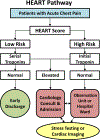The HEART Pathway Randomized Controlled Trial One-year Outcomes
- PMID: 29920834
- PMCID: PMC6934171
- DOI: 10.1111/acem.13504
The HEART Pathway Randomized Controlled Trial One-year Outcomes
Abstract
Objective: The objective was to determine the impact of the HEART Pathway on health care utilization and safety outcomes at 1 year in patients with acute chest pain.
Methods: Adult emergency department (ED) patients with chest pain (N = 282) were randomized to the HEART Pathway or usual care. In the HEART Pathway arm, ED providers used the HEART score and troponin measures (0 and 3 hours) to risk stratify patients. Usual care was based on American College of Cardiology/American Heart Association guidelines. Major adverse cardiac events (MACE-cardiac death, myocardial infarction [MI], or coronary revascularization), objective testing (stress testing or coronary angiography), and cardiac hospitalizations and ED visits were assessed at 1 year. Randomization arm outcomes were compared using Fisher's exact tests.
Results: A total of 282 patients were enrolled, with 141 randomized to each arm. MACE at 1 year occurred in 10.6% (30/282): 9.9% in the HEART Pathway arm (14/141; 10 MIs, four revascularizations without MI) versus 11.3% in usual care (16/141; one cardiac death, 13 MIs, two revascularizations without MI; p = 0.85). Among low-risk HEART Pathway patients, 0% (0/66) had MACE, with a negative predictive value (NPV) of 100% (95% confidence interval = 93%-100%). Objective testing through 1 year occurred in 63.1% (89/141) of HEART Pathway patients compared to 71.6% (101/141) in usual care (p = 0.16). Nonindex cardiac-related hospitalizations and ED visits occurred in 14.9% (21/141) and 21.3% (30/141) of patients in the HEART Pathway versus 10.6% (15/141) and 16.3% (23/141) in usual care (p = 0.37, p = 0.36).
Conclusions: The HEART Pathway had a 100% NPV for 1-year safety outcomes (MACE) without increasing downstream hospitalizations or ED visits. Reduction in 1-year objective testing was not significant.
© 2018 by the Society for Academic Emergency Medicine.
Figures
Comment in
-
In patients with chest pain, HEART Pathway-guided and usual care did not differ for MACE or health care use.Ann Intern Med. 2018 Dec 18;169(12):JC69. doi: 10.7326/ACPJC-2018-169-12-069. Ann Intern Med. 2018. PMID: 30557422 No abstract available.
Similar articles
-
The HEART Pathway randomized trial: identifying emergency department patients with acute chest pain for early discharge.Circ Cardiovasc Qual Outcomes. 2015 Mar;8(2):195-203. doi: 10.1161/CIRCOUTCOMES.114.001384. Epub 2015 Mar 3. Circ Cardiovasc Qual Outcomes. 2015. PMID: 25737484 Free PMC article. Clinical Trial.
-
Prehospital Modified HEART Score Predictive of 30-Day Adverse Cardiac Events.Prehosp Disaster Med. 2018 Feb;33(1):58-62. doi: 10.1017/S1049023X17007154. Epub 2018 Jan 10. Prehosp Disaster Med. 2018. PMID: 29316995
-
Performance of the EDACS-accelerated Diagnostic Pathway in a Cohort of US Patients with Acute Chest Pain.Crit Pathw Cardiol. 2015 Dec;14(4):134-8. doi: 10.1097/HPC.0000000000000059. Crit Pathw Cardiol. 2015. PMID: 26569652 Free PMC article.
-
Outcomes after coronary computed tomography angiography in the emergency department: a systematic review and meta-analysis of randomized, controlled trials.J Am Coll Cardiol. 2013 Feb 26;61(8):880-92. doi: 10.1016/j.jacc.2012.11.061. Epub 2013 Feb 6. J Am Coll Cardiol. 2013. PMID: 23395069
-
Prognostic Accuracy of the HEART Score for Prediction of Major Adverse Cardiac Events in Patients Presenting With Chest Pain: A Systematic Review and Meta-analysis.Acad Emerg Med. 2019 Feb;26(2):140-151. doi: 10.1111/acem.13649. Epub 2018 Nov 29. Acad Emerg Med. 2019. PMID: 30375097
Cited by
-
Use of downstream stress imaging tests for risk stratification of patients presenting to the emergency department with chest pain and low HEART score.Open Heart. 2024 Aug 25;11(2):e002735. doi: 10.1136/openhrt-2024-002735. Open Heart. 2024. PMID: 39214533 Free PMC article.
-
Brazilian Society of Cardiology Guidelines on Unstable Angina and Acute Myocardial Infarction without ST-Segment Elevation - 2021.Arq Bras Cardiol. 2021 Jul;117(1):181-264. doi: 10.36660/abc.20210180. Arq Bras Cardiol. 2021. PMID: 34320090 Free PMC article. English, Portuguese. No abstract available.
-
Major adverse cardiac event rates in moderate-risk patients: Does prior coronary disease matter?Acad Emerg Med. 2022 Jun;29(6):688-697. doi: 10.1111/acem.14462. Epub 2022 Mar 31. Acad Emerg Med. 2022. PMID: 35166427 Free PMC article.
-
Validation and modification of HEART score components for patients with chest pain in the emergency department.Clin Exp Emerg Med. 2021 Dec;8(4):279-288. doi: 10.15441/ceem.20.106. Epub 2021 Dec 31. Clin Exp Emerg Med. 2021. PMID: 35000355 Free PMC article.
-
2023 Society for Academic Emergency Medicine Consensus Conference on Precision Emergency Medicine: Development of a policy-relevant, patient-centered research agenda.Acad Emerg Med. 2024 Aug;31(8):805-816. doi: 10.1111/acem.14932. Epub 2024 May 23. Acad Emerg Med. 2024. PMID: 38779704 Free PMC article.
References
-
- Owens PL, Barrett ML, Gibson TB, Andrews RM, Wei-nick RM, Mutter RL. Emergency department care in the United States: a profile of national data sources. Ann Emerg Med 2010;56:150–65. - PubMed
-
- Pope JH, Aufderheide TP, Ruthazer R, et al. Missed diagnoses of acute cardiac ischemia in the emergency department. N Engl J Med 2000;342:1163–70. - PubMed
Publication types
MeSH terms
Grants and funding
- 13CRP17090055/AHA/American Heart Association-American Stroke Association/United States
- Duke Endowment/International
- 12CRP12000001/AHA/American Heart Association-American Stroke Association/United States
- Abbott Point of Care/International
- M01 RR007122/RR/NCRR NIH HHS/United States
- Roche Diagnostics/International
- Siemens by providing software for cardiac imaging research/International
- SAM is the chief medical officer of Impathiq, Inc./International
- Wake Forest Translational Science Institute/International
- L30 HL120008/HL/NHLBI NIH HHS/United States
- R01 HL118263/HL/NHLBI NIH HHS/United States
- AAMC/Donaghue Foundation/International
LinkOut - more resources
Full Text Sources
Other Literature Sources
Medical



